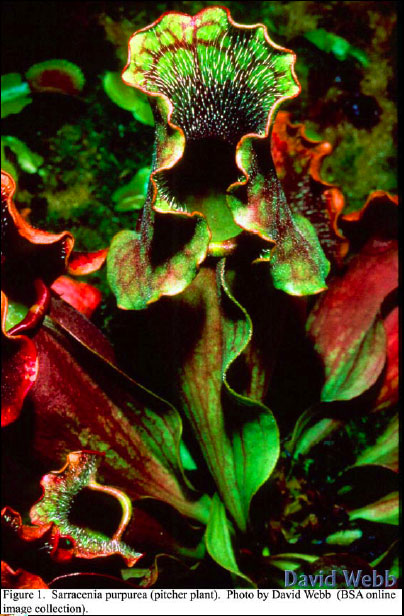Sarracenia - the Pitcher PlantsCarnivorous Plants / Insectivorous Plants
A common plant in the bogs of the northeastern part of North America is Sarracenia purpurea (pitcher plant, Figure 1). Although its large leaves resemble tall pitchers partially filled with water, they are also good mimics of flowers, and it is the latter trait that fools both insects and humans. Although humans have nothing to fear if they try to smell the false flowers, flies easily become victims of the pitfall trap when they seek potential food inside. As the summer season progresses, the leaves become purplish red from the presence of anthocyanins, making them a lure to flies who are probably also attracted by the decaying amino acid odor of already trapped prey. Once the fly enters the hollow leaf, it confronts a waxy surface leading to a pool of water. Although a fly can often escape the surface of water, the pitcher plant reduces its chances by supplying a wetting agent that wets the fly's wings and prevents it from flying. Even if the fly succeeds in escaping the surface of the water, it is confronted by the steep sides of the leaf and, being unable to fly straight up like a helicopter, is forced to crash into the walls of the leaf. We have all seen flies climb the walls of our houses, but this leaf wall is somewhat more challenging. 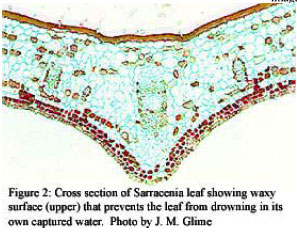 The lower part of zone 3, (in Figure 3) is waxy and very slippery. The fly's feet soon slide like stepping onto a newly waxed floor in your sock feet. But if the fly does succeed in passing above that waxy zone, it is confronted with downward pointing hairs (Figure 4) in zone 1 (Figure 3), again preventing escape. Eventually the exhausted fly succumbs to the solution at the bottom of the leaf and the low pH slowly digests its tissues. The plant seems to contribute little to the digestion process, but bacteria living in the pitcher provide digestive enzymes. Trapping of ants can be important to the digestion process as well. Along the outer edge of the leaf is a flat flange (Figure 5) that provides a trail of a sweet nectar-like substance leading to the opening of the pitcher. Ants often follow this trail and enter the pitcher, getting trapped in a manner similar to that of the fly. 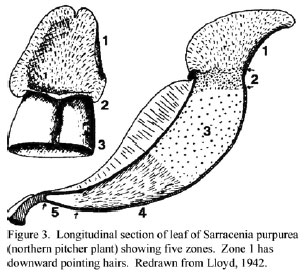 Since ants are common in the Sphagnum hummocks of a bog, it is not too surprising that this plant is attractive to them. The abundant Sphagnum is certainly not one of their food plants. Once inside the pitcher (Figure 6), the ant dies and decays, thus releasing the formic acid made by the ant (formic acid results in the nasty stings some ants can cause). The formic acid contributes further to the digestive process, making the pH as low as 2.0. For Sarracenia in the southeastern United States, it appears that mineral nitrogen and phosphorus are not important limiting nutrients (Eleutarius & Jones 1969). However, when Christensen (1976) fed insects to one species, the concentrations of nitrogen and phosphorus in the leaf tissue was significantly higher than in controls. But pitcher plants are not only captors, they are also hosts to a variety of small organisms. 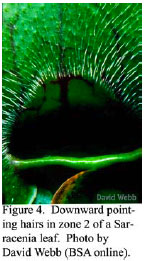 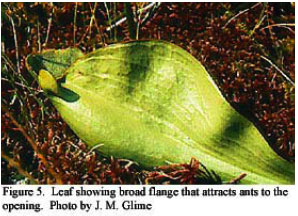 Several species of mosquito larvae complete their larval stage here, exiting to the surrounding moss to live out the pupal stage. A slightly larger inhabitant, the larva of the blowfly, Sarcophaga sarraceniae, spends its larval life deep at the bottom of the tube where it enjoys the decaying parts of the captive prey. When it matures to form the pupal stage, it likewise leaves the pitcher to pupate among the surrounding moss. But as an adult, it returns to the pitcher plant, this time to steal nectar from the flower and at the same time to pollinate it. Small organisms are not the only ones to inhabit these pitchers. Small frogs sit and wait in some species, taking advantage of the flies that are attracted by the odor. 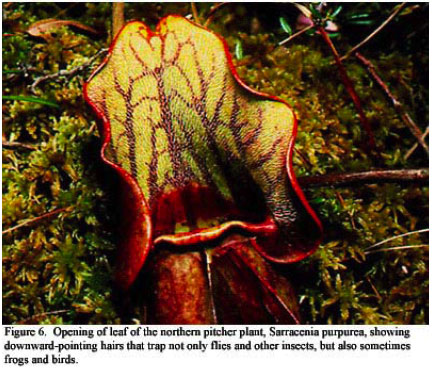 The pitcher plant has not only unique leaves, but very strange flowers as well (Figure 7). Its petals are ordinary enough, with a deep burgundy color that attracts flies by looking like raw meat. But that is where its similarity to normal flowers seems to end. The sepals, usually green structures that protect the bud and then become inconspicuous when the flower opens, remain long after the petals fall off. In fact, the petals fall off quickly because they have very narrow attachments. The sepals are leathery and will even last through the snows of a northern winter! They usually become reddish themselves if they are exposed to direct sun (Figure 7). 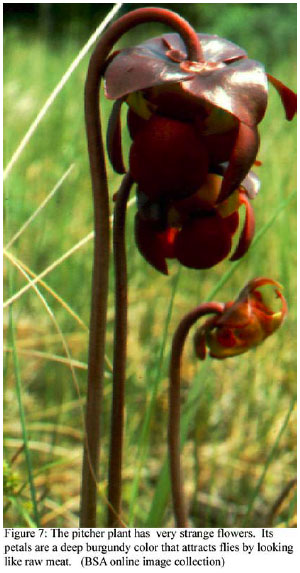 The pistil, or female part of the flower, is the strangest part. It has a normal enough ovary that provides the enlarged base of the pistil, but the style expands into a large, star-shaped umbrella (Figure 8). This umbrella becomes the lowest part of the flower as it droops downward in its early open stages. As a result, the pollen that awaits in the anthers surrounding the ovary has a waiting landing platform. Soon the inside of the umbrella-shaped style is laden with pollen. And, the ovary drips nectar onto the platform as well. 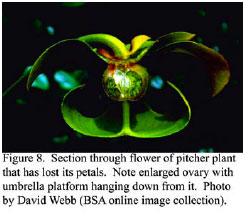 When the blowfly approaches the flower, it first lands on one of the five points of the star, not suspecting that it has landed on the awaiting stigma that is ready to receive whatever pollen may have stuck to the body of the fly. From there, the fly descends onto the platform, where it crawls around gathering nectar, and inadvertently, pollen. When the fly tires of that flower, it will exit between the points, not across them, on its way to another flower. Ca. 10 Listed Species INSECTIVOROUS (CARNIVOROUS) PLANT REFERENCES |
